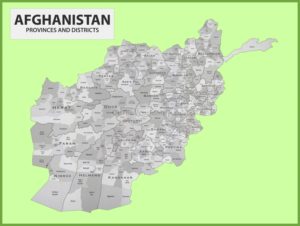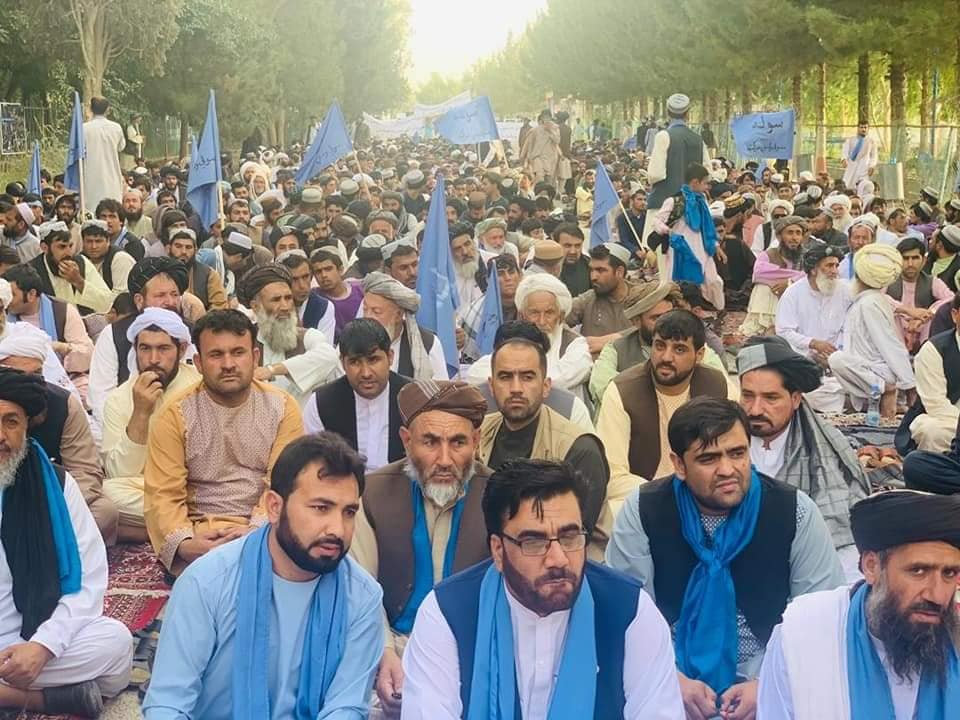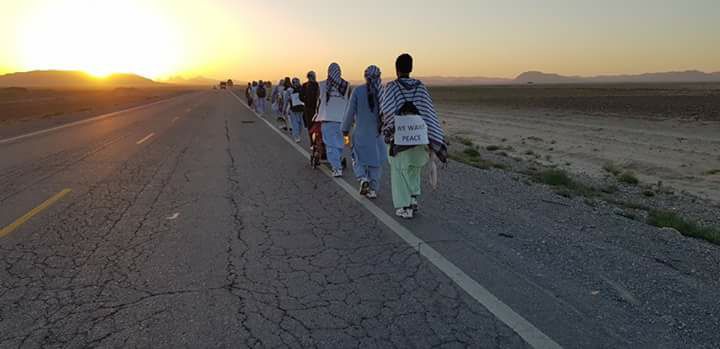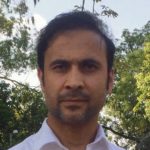Minds of the Movement
An ICNC blog on the people and power of civil resistance
by Ahmadullah ArchiwalMay 11, 2020
On March 26, 2018, a suicide car bomb hit a stadium in Lashkargah, the capital of Helmand province in Afghanistan. The attack killed dozens of football fans who had gathered in the stadium to watch the game. A number of civilians who lost their dear ones in the attack sat in protest to criticize the attack. They erected protest tents in Lashkargah and observed a hunger strike. The demonstrators made specific demands, including:
• Observing ceasefire during Ramadan;
• Relaunching ceasefires;
• Bringing into existence a political setup that is acceptable to all sides; and
• Starting the intra-Afghan dialogue that can result for a timeline for the withdrawal of international military forces.
The activists issuing these demands soon also decided to march to the national capital of Kabul, and this led their efforts to be popularly referred to as the “Helmand Peace March.” Despite this popular label, it is technically more accurate to refer to them as the “Helmand Peace Movement,” and therefore I use both terms interchangeably.
In this article, I aim to evaluate the Helmand Peace March by using several criteria established by leading thinkers and scholars in the field of civil resistance. I then make some recommendations. The information I cite is based on a series of interviews with Helmand Peace Marchers, media reports, and my personal observations. The importance of this case study is clear in Afghanistan, but its relevance goes well beyond this, as movements for peace in the face of armed conflict occur and are relevant to countries in many other parts of the world.

Map of Afghanistan (click to enlarge). Source: ontheworldmap.com.
A 700km journey
After protesting from their tents in Lashkargah for over a month, the marchers continued to hold meetings with youths, tribal chiefs, religious scholars, and ordinary people from Helmand. On May 13, 2018, 70 marchers started to walk from Helmand towards Kabul, growing to a few hundred over the 700km distance. Participation of other Afghans on their way in Kandahar, Zabul, and Ghazni diversified the peace march.
This march entailed significant risk. Not only were the geography and weather unfavorable, but marchers also risked being attacked by the armed opposition of the Afghan government or other armed bandits and criminals on their way to Kabul. Under the blazing sun with an intensity of 40 degrees Celsius (104 degrees Fahrenheit), while observing the mandatory fasting of Ramadan, the marchers walked through areas controlled by either the Taliban, the Afghan government, or contested between the two parties.
Once they reached Kabul after a 40-day walk full of hardships, the marchers erected tents in the Chamani Huzuri in Kabul. This makeshift office-tent became the headquarters for marchers in Kabul. From here, they issued press releases and staged sit-ins in front of the U.S. embassy, the United Nations Assistance Mission in Afghanistan (UNAMA), and other important locations in Kabul. In addition, they made the headlines in national news and, to a limited extent, in international media too.
Prior to marchers’ arrival in Kabul, similar marches began in other parts of the country. Marchers from other provinces staged walks to Kabul, erected tents there, and echoed the voice of Helmand Peace Movement in Kabul. Young people from different parts of the country joined as well.

Helmand Peace March, Afghanistan. Source: Iqbal Khyber Facebook page.
Impacts and challenges
The movement has had a number of notable impacts in the two years it has been active:
• The march has channeled the voice of ordinary Afghans who want peace, which is a large percentage of the population. These people have often been overlooked and were previously passive in the conflict. Critically, the marchers showed that these people and their voices have power, which challenged the notion that only armed groups define the course of events in Afghanistan. In over 40 years of civil war in Afghanistan, this is the only prominent nonviolent movement that has attracted attention from the government and the Taliban. The Afghan president Ashraf Ghani invited the marchers to meet him in the presidential palace. After they refused, the president went to their tent and declared his readiness to observe a ceasefire if the Taliban agrees to it. They also risked their lives and met the Taliban in their areas. Associating them with the government, the Taliban detained them a number of times but released them after sometime (author interview with movement leader Iqbal Khyber).
• The Afghan government and the Taliban observed a three-day ceasefire in Eid in summer 2018 for the first time in the 17-year armed conflict. It is not clear whether the march was the main cause or just a contributor to the ceasefire. However, the marchers claim credit for the ceasefire.
• The movement was able to overcome ethnic and linguistic barriers and prompted similar marches in other parts of Afghanistan.
• Apart from women's participation, the movement also brought representation from Afghans of all ages, even disabled persons, joining the march.
• The marchers’ courage demonstrated to young people their ability to face any threat, including the threat to face armed opposition of the government.
• The march has remained neutral in the armed conflict, which gives it credibility.

"We want peace." Source: Sayed Hotak Facebook page.
Despite these immense successes, the march has faced many challenges as it grows from a march to a more sustainable and growing movement. As a movement, it lacks a strategy that clearly defines vision, goals, tactics, resources, communication, and recruitment of new supporters. The goals they presented at the outset need to be divided into short-term and medium-term goals.
In addition, a major problem for the Helmand Peace March and similar peace marches in Afghanistan is the absence of, or at least outreach to, all parties in the conflict. Although some marchers met with the Taliban, the Taliban are in general hard to reach, even though they still rely heavily on public consent and popular support for their legitimacy. Diversifying tactics will help the movement pressure the Taliban and the Afghan government to listen to them. Sufficient public outreach to ordinary people, human and financial resources for the movement, and training new recruits are other problems that the movement is wrestling with.
Recommendations
One of the main challenges for nonviolent movements in Afghanistan is the general perception of nonviolence. Though we don’t have data to back this claim, people consider nonviolence to be a weak form of resistance. The notion has to change before more people will be able to support nonviolent movements. To expand on what I have evoked above:
• The peace march needs to have a well-defined strategy that includes at least their goals, vision, tactics, communication mechanisms, resources, and new recruit training. The communication mechanisms need to be designed in a way that attracts support from all strata of society, including religious scholars and tribal chiefs.
• The movement needs to diversify their tactics to exert more pressure on the warring parties to succumb to their demands. The movement needs to come out of the first step of mobilizing people—it must employ tactics that are not symbolic but instead challenge the target group's ability to keep the status quo.
• Intensive public outreach is needed to attract more individuals to the movement—youths in particular, as they carry so much energy but are at risk of radicalization. At the end of the day, numbers matter.
• Proper structure and well-defined leadership are also important for the movement to reach to its goals. A leadership style that is based on realities on the ground needs to be adopted.
The Helmand Peace March is an unprecedented nonviolent movement in recent Afghan history. The movement still resorts to marches and holding gatherings in different parts of the country as its primary tactic. This has helped the movement dramatize the pain and suffering of Afghans and their demands for peace.
Like with many nonviolent movements, the Helmand Peace March faces the difficult reality of maintaining momentum and ensuring sustainability. The way forward for the movement is to continue to reinforce their passion and commitment by thinking more strategically and defining their short-term, medium-term, and long-term goals; generating resources for their daily activities; and securing new allies from within all parties to the conflict. The movement also needs to stay neutral politically, so as to keep their integrity as a force for change in Afghan society intact.

Ahmadullah Archiwal
Ahmadullah Archiwal has two MAs, one in journalism and mass communication from the University of Peshawar (Pakistan) and one in international affairs from the New School University in New York (USA), where he studied as a Fulbright scholar. Archiwal has done pioneering work on civil resistance and has authored three books—two on Khudai Khidmatgar, and one on nonviolent civic mobilization in Pashto.
Read More